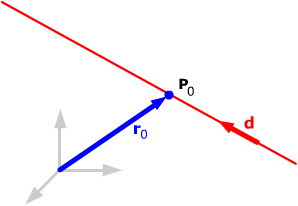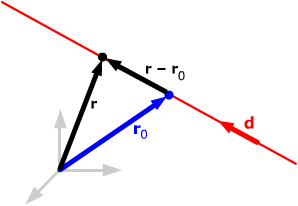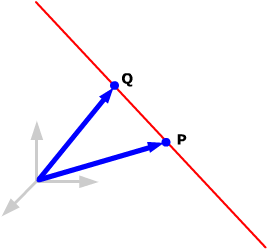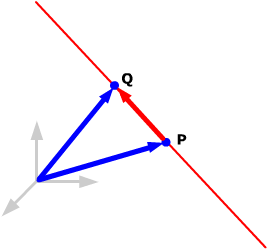Lines
To describe a line, you need two pieces of information: a point on
the line and a direction for the line.
The point can be specified as usual by its coordinates or its position
vector r0,
and the direction by a non-zero direction
vector d.
Neither of these is unique; you can choose any point on the line and
any direction vector parallel to the line (all direction vectors will
thus be scalar multiples of each other).
|
 |
Now, suppose r is the position vector
of a generic point on the lline. The vector r
– r0
is parallel to d, so for some scalar
t, r – r0
= td, i.e. r
= r0
+ td.
|
 |
The vector equation for a line
through the point with position vector r0
and with direction vector d is
r = r0
+td
where t is a parameter ranging over all real numbers.
|
Now let's be more specific and use coordinates. Suppose that
- the point has coordinates (x0, y0,
z0), so its position vector is r0
= x0i
+ y0j
+ z0k
- the direction vector is d = ai
+ bj + ck.
For a generic point r = xi
+ yj + zk on
the line, we get
|
xi + yj
+ zk
|
= (x0i
+ y0j
+ z0k)
+ t(ai + bj
+ ck)
= (x0 +ta)i
+ (y0 + tb)j
+ (z0 + tc)k.
|
Set the i-, j-
and k-components on each side equal to each
other to get another way of representing the line.
The parametric equations for
a line through the point P(x0,
y0, z0)
with direction vector d = ai
+ bj + ck
are
x = x0 + ta
y = y0 + tb
z = z0 + tc
where t is a parameter ranging over all real numbers.
|
Given the parametric equations of a line, you should be able to read off a
point on that line and a direction vector for the line. For example, if you're
given the line
x = 2 – 3t
y = 3 + 4t
z = –1 + 5t
you should recognize immediately that the line goes through the point (2,
3, –1) and has
a direction vector –3i
+ 4j + 5k.
For most problems involving lines, you will not be given a direction vector
and point directly; you'll usually be given information that can be used to
find them.
: Find parametric equations for
the line through the points P(1, –2, 3)
and Q(4, 0, –3).
Draw a sketch (always!). To find a line, you need both
a point and a direction vector. You have two points to choose from, but
you need to find a direction vector.
|
 |
From the sketch you can see that the vector PQ
lies along the line and so can be used as a direction vector. Calculate:
PQ = 3i
+ 2j –6k,
so using P for the point, the line has
parametric equations:
x = 1+ 3t
y = –2 + 2t
z = 3 – 6t
|
 |



